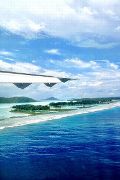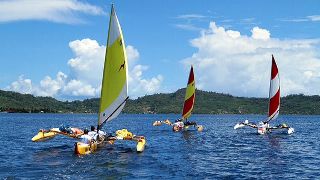|
Alyssa will be checking in each day from the 2012 IronMana Bora Bora Liquid Festival. Come back here for updates throughout the week. The Road to IronMana: Intro | Day 1Before I type another word this week, I need to say this: I know. I know how lucky I am to be writing this piece from a private deck outside of a private bungalow on a private island in French Polynesia while my colleagues are toiling away at MLB winter meetings in Nashville or freezing their tushes off covering late-season games in Green Bay. I know I owe my editor a stint as the late-night curling reporter at the next Olympics, as well as a very nice gift. Remind me: What size are you in Tahitian black pearls?  And I know, without question, this will not be the last time I visit Bora Bora, nor will it be the last time I attend the Liquid Festival. And I can say that after spending only one day on this island, meeting and talking with some of the more energizing people I've met in a long time. There are two ways to travel to Bora from the United States. You can take an eight-hour daytime flight from LAX to Papeete, Tahiti's capital city, spend the night in Papeete and fly to Bora the next morning (what I did) or take an overnight flight from LAX, spend a few hours at the Papeete airport and then take that same a.m. flight to Bora. Either way, you arrive at your final destination -- which after landing on Bora Bora, requires a boat ride to your hotel -- around midday. For those of us here to cover or participate in the Liquid Festival, today was a lay day. But for the event's organizers, it was a rest day. Yesterday afternoon (which was Sunday, as it is now 11 p.m. TAHT on Monday as I sit down to write this), event organizer Stephan Lambert and eight other men (three Americans, five Tahitians) arrived after sailing 400 kilometers from Tahiti to Bora Bora aboard traditional three-man Hawaiian outrigger sailing canoes. The channel crossing took four days and 40 hours of sailing and paddling and included stops on the islands of Moorea, Raiatea and Tahaa. This is the third year Lambert has opened the event with a channel crossing, a grueling test of mental and physical strength that also serves to announce the start of the festival to the people of Tahiti. Last year, Lambert captained the only Holopuni on the journey. (Holopuni, which means "to sail everywhere" in Hawaiian, are modern-day versions of ancient sailing canoes developed by Kauai local Nick Beck, who founded the Hawaiian Canoe Sailing Association in the early 1970s and was one of the captains on this crossing.) This year, his flock grew to three boats, and at each stop, local Tahitians greeted the sailors on the beach and welcomed them into their homes. "It's not often the local people see sailing canoes coming to their island, and they're curious people," said Lambert, who utilizes social media to let locals know when the crossing is coming to their island. Each year, the trip takes a different route, as does the five days of stand-up paddleboarding (SUP), OC-3, surf-ski and open-water swimming racing that follows on Matira Beach. "The concept is to never do the same event two years in a row," Lambert says in a thick, French accent. "I like that we start with the beginning of a story, but we write the rest of the story as we go along." And as he goes along, he collects a fascinating cast of characters. That, too, is part of Lambert's goal: to inspire future watermen and women to carry on these ancient sports long after he and Nick are gone and gather them, once a year, to celebrate. On Wednesday morning, Lambert and his crossers will teach local children the art of the sailing canoe and, in the years to come, hope their channel crossing grows to include sailors, paddlers and outdoor aficionados from around the world, men and women wishing to challenge themselves for 400 kilometers in one of the most beautiful settings on earth. "The journey of a channel crossing is a human experience, an inside experience. It's not about racing. It's about asking more from yourself," Lambert said. "The more you push your limits, the more you feel alive. That's not being a masochist. That's being an explorer. Most see pain as a wall and they stop at that wall. But I believe what is behind that wall is nice, you just need to have faith that whatever is on the other side will be good. "After pain comes joy. A crossing like we just did was a challenge, but it will give us six months of energy." This, I quickly learn, is how Lambert speaks, in a sort of extreme poetry. He is an intense, taciturn fellow. But the few words he chooses are worth your ear. Originally from Cannes, France, and a professional tennis player until his mid-teens, Lambert visited Hawaii for the first time at 15 and fell in love. Shortly afterward, he quit tennis, moved to Hawaii and, for the past 18 years, has called Tahiti home. Thirteen years ago, his passion for the outdoors and a desire to spread the gospel of wellness and water sports inspired him to start the first of these festivals, part grueling endurance race, part celebration of Polynesian seafaring culture. This year's event hasn't even started, and I already can't wait for 2013.
|

